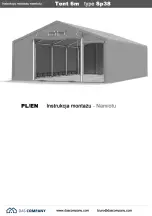
Page 8 of 9
RV-5/3 Plus Owner’s Manual
Ventilation
Maintain adequate ventilation inside your tent at all times.
Campsite Choice
When choosing a campsite, carefully consider the possibility of falling rocks or tree limbs, lightning, flash floods,
avalanches, strong winds, and other potential hazards to reduce the risk of loss or injury to the tent or occupants.
Select a site that’s level, will drain well if it rains, and is protected from wind and other elements. Clear the area of sharp
stones, sticks, and other debris, both for comfort and to protect your floor. If possible, avoid setting the tent on ground
that is already wet. If you can’t minimize the resulting humidity and potential of condensation by keeping your tent well
ventilated.
Pegs/Stakes and Ropes
Peg down your tent properly at all times to reduce the risk of loss or injury to the tent or occupants.
All tents require pegging/staking to prevent them from flying away in a gust of wind. Always anchor your Oztent. Enough
pegs/stakes and ropes are supplied to safely set up your tent in most situations. It may be necessary to purchase
additional and/or specialised pegs/stakes and ropes for use in extreme or varied soil conditions. For optional sand pegs/
stakes Oztent recommends use of an Oztent Edition Bluescrew.
Tightly tensioning your tent with our attached ropes greatly increases the tent’s strength and stability. This will also
reduce fabric droop and wrinkles, and prevent rainwater from pooling. To pull out a peg never use the edge of the tent as
a handle. If hard to remove, use of another peg as a hook is recommended.
Zippers
Be careful with your zippers. Go slow when zipping. Make sure to align the tracks before sliding the zipper - and don’t
exert excessive force. If fabric gets caught in the slider, stop and slowly reverse the slider to remove. A silicone based
lubricant may be used to enhance zipping.
When dirt gets in the zipper teeth, they can cause abrasion and damage to the zipper sliders. You can clean the zipper
teeth by rinsing them out with water. The pressure from a regular garden hose will push out small sand particles.
Cleaning
If your tent should require cleaning, set it up and use a sponge with warm water. If further cleaning is needed, a garden
waterproofing and/or damage the fabric. Allow the tent to air-dry completely before packing or storing.
Condensation
Condensation is an unavoidable fact of physics. When warm, moist air comes in contact with the cool tent fabric, it forms
condensation. In most conditions condensation can be controlled by allowing air inside the tent to vent outside. During
high degree of ventilation can actually increase the condensation by drawing in more humid air.
To reduce condensation, use Oztent Fly. Your Oztent Fly is designed to collect humid air that passes through your tent. It
is normal to find the underside of the fly covered in water droplets in humid conditions.
Condensation can also collect on parts of the floor inside the tent. This is also normal and does not indicate leaking
fabric.
Safety and Care Considerations






























